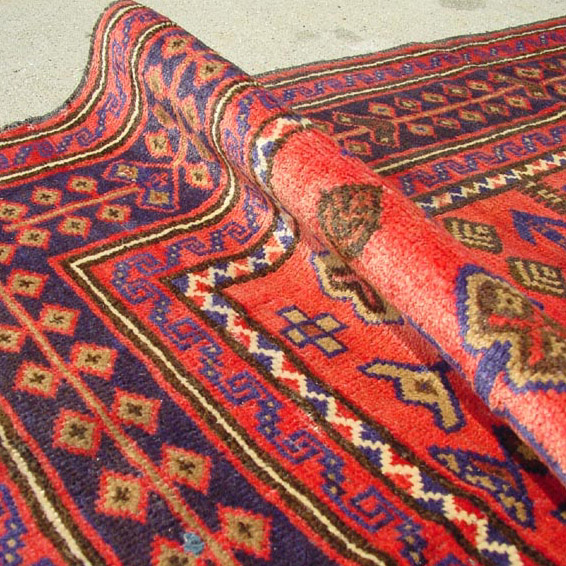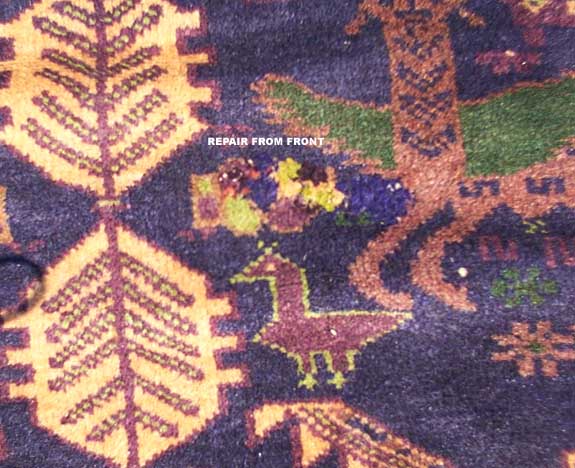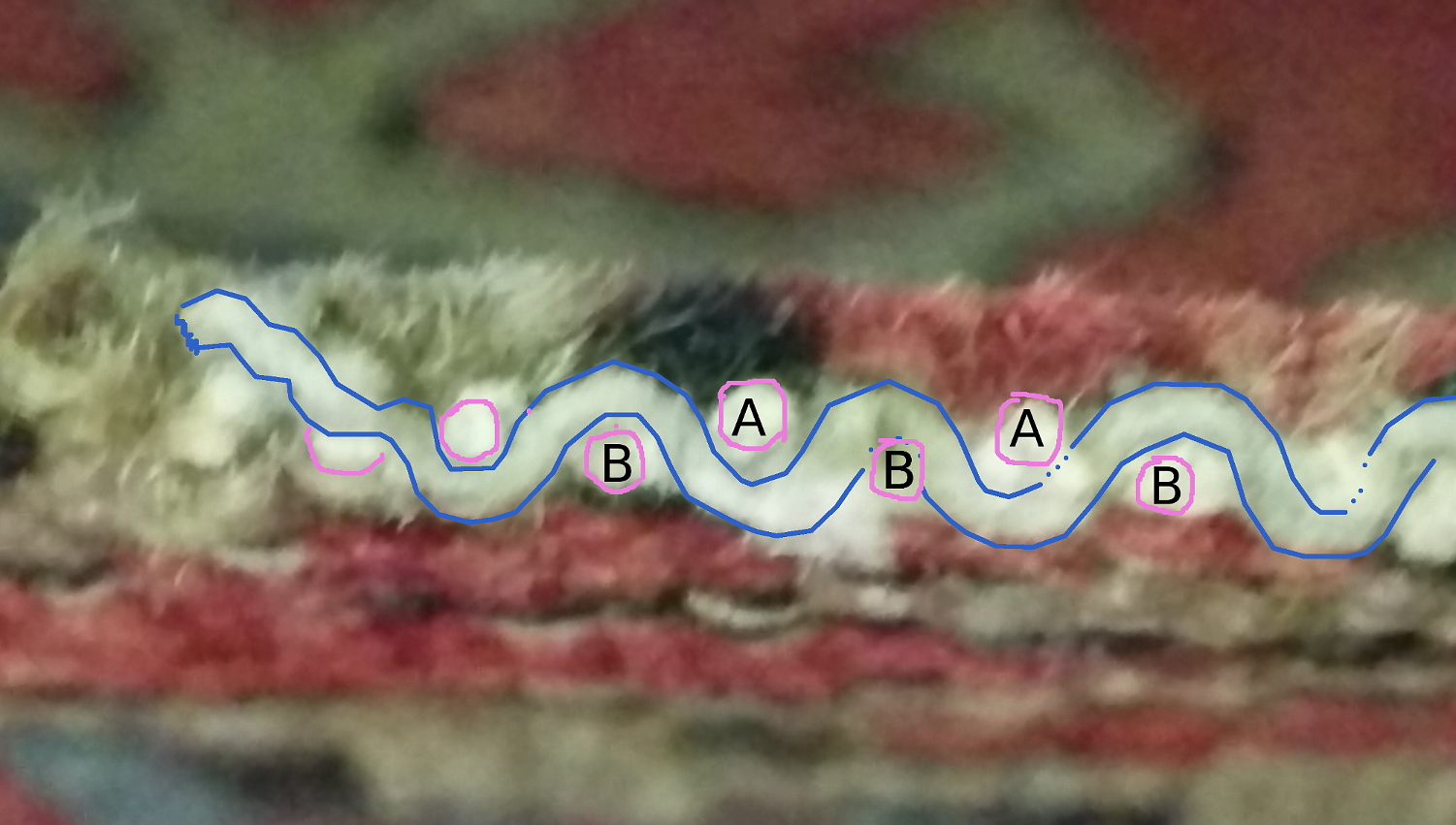--------> Fringe
|
The ends of the warp threads make the fringe of a rug. The entire rug is founded on these threads that become the fringe. Tribal rugs, particularly those from Afghanistan, often have short kilim skirts that protect the pile from damage. In our descriptions the fringe consists of three parts: kilim skirt, closure, and fringe. Kilim skirts offer a wide array of interesting woven structures that inform us as to the origin of a particular rug. More examples of war rug Fringe |
--------> Selvedge
|
The selvedge of a rug is where the weft threads reach the end of a rug, turn around and re-enter the rug. Different weavers use different selvedge techniques, so selvedge is an indicator of a rugs origin. More examples of war rug Selvedge |
--------> Handle
|
How a rug feels in the hand is called handle. The primary factor in handle is the flexibility of a rug, for example, is it floppy or firm. To represent handle through photos we fold a rug and judge the diameter of the fold.
An example of an extremely floppy handle is this Ali Khoja or Ali Kwaja rug, #1812. The rug folds over on itself, like a piece of cloth, so the diameter of fold is very small. Here is another example or a very floppy handle, also Ali Khoja, Fine Ali Kwaja Vase of Flowers Rug Rug #802. The handle can also be discerned in the wrinkle photos. Most Baluchi rugs are floppy, but not as floppy as the Ali Kwaja above. Here are a couple of examples: floppy handle of rug #, and floppy handle of rug #. Turkmen rugs tend to have stiffer handle, in part because they are more likely to have depressed warps. This photo illustrates well a stiff handle producing a wide diameter when folded. It is a Medallion Drone rug , #1689, Drone Medallion on Sky Blue Field. Here is another example of wide diameter handle in a rug of similar structure, UXO Unexploded Ordnance Rug #1804. More examples of war rug Handle |
--------> Sheen
|
The sheen of a rug is the luster of the pile. As rugs age the sheen improves. Sheen also indicates the quality of the wool use for the rug's pile. More examples of war rug Sheen |
 |
--------> Weft
|
Weft threads run horizontally across the rug, perpendicular to the<$wp> warp. A rug may have one or more weft threads between each row of pile. In pile rugs, weft threads are used to lock in rows of pile knots. In most flat weaves, weft are the threads that form the rugs design. More examples of war rug Weft |
--------> Damage
|
A good quality rug is utterly repairable. Prompt and professional repairs greatly improve the longevity of a rug. While repairs are never desirable, a well done repair to a good rug, does not greatly diminsh a rugs value. More examples of war rug Damage |
--------> Plain Weave
|
This is the most basic weave. The warp and weft alternately form the surface of this type of textile. More examples of war rug Plain Weave |
--------> Weft Brocade
|
Supplemental wefts are floated on the surface of the textile. More examples of war rug Weft Brocade |
--------> Weft Substitution
|
This is a very strong structure where supplemental wefts are added to create a strong design on the face of a fabric, while reinforcing the back of a fabric very substantially. More examples of war rug Weft Substitution |
 |
--------> Washing
Rugs are washed and blocked after weaving. Some washes have pronounced effect on the aeshtetic of the rug.
More examples of war rug Washing |
||||||||
--------> Dyes
|
Colors More examples of war rug Dyes |
--------> Repairs
|
Various repairs to rug More examples of war rug Repairs |
 |
--------> Abrash
|
Abrash means the color variations caused by a threads position in the dye and variations in dye lots. The result can be very very beautiful, and in antique rugs it ads considerable value.
Abrash may show individual skeins of wool where the color breaks in chunks, like this example in Rug #39, Abrash War Rug from the earliest days of warrug.com. Abrash is also found within a skein of wool, where the outside absorbs more color than the inside causing subtle gradations of color, like this example #1689, Drone Medallion on Sky Blue Field War Rug. More examples of war rug Abrash |
--------> Knotted Pile - and examples of quality
|
Knotted pile is the structure of most Afghan rugs, as well as most of what we think of as Persian or Oriental Rugs. Knotted pile is made when a thread is tied around two warps and sandwiched between two wefts. The thread points upwards from the foundation and is the point of the rug we touch. More examples of war rug Knotted Pile - and examples of quality |
--------> Gul-i-birjista (knotted pile on a ground of weft brocade)
|
Gul-i-birjista rugs feature a combination of techniques that render a special and unique combination of textures. Usually Gul i'birjista features weft brocade, or sumac, backgrounds with knotted pile figures or patterns.
In Afghan rugs, gul i'birjista usually indicates Taimani production in Herat and Farah provinces. In the late 2000's they tended to be white fields with blue, black, and red pile, like this rug, #1468, 2007 City Scene Sumac Afghan War Rug. Earlier examples though were more stylistically diverse, like this rug but with some of the same traits, like More examples of war rug Gul-i-birjista (knotted pile on a ground of weft brocade) |
--------> Painting
|
Sometimes, REGRETTABLY, some jackass may think a rug has a color problem that applying a supplementary color will fix. Mostly, it is disastrous and ruins the value of a rug. More examples of war rug Painting |
--------> Warp Depression, a.k.a. Double Knotted
|
Warp depression is the most challenging concept in rug structure. Each knot, whether Persian (asymmetric) or Turkish (symmetric) is tied to two warp threads. Warp threads can lie in one plane (not depressed) or they can lie in two planes offset by an angle of depression. Full warp depression, a.k.a. double knotting, has the two planes offset by nearly 90 degrees, so from the back one can only see one of the two warps. This blog post is a primer from 2009 on warp depression, but this Structures Page and this blog post attempts to make it clear, as does this Structure Element. More examples of war rug Warp Depression, a.k.a. Double Knotted |
 |
--------> Fuzz on back of rug indicating new condition
|
When rugs are brand new the pile threads create a fuzz on the back of the rug, as seen int these photos. When the rug is used on the floor, this fuzz wears off in a short time. More examples of war rug Fuzz on back of rug indicating new condition |
--------> Marling: two threads of different colors plied together
|
Marling, like checkering, gives a half-tone effect to a rug. Marled threads are made from two threads of different colors plied together. More examples of war rug Marling: two threads of different colors plied together |
--------> Sarnach, meaning "head of the thread"
|
Sarnach are where warp or weft threads are tied together to make longer, continuous threads. The knots leave a bump and usually leads to a missed pile not. More examples of war rug Sarnach, meaning "head of the thread" |
--------> Singles, the threads that are knotted to make pile
|
Singles are the threads that are wound together, not plied, and used for the pile on knotted pile rugs.
As usual, the best info about rug structures is from Marla Mallet(external lin), and her description of "singles" is a clear delineation of the concept (external link). More examples of war rug Singles, the threads that are knotted to make pile |